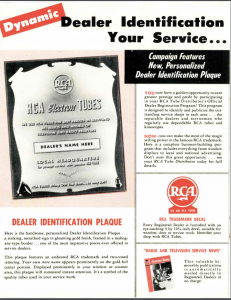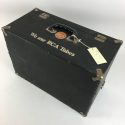The RCA Servi-Chest: a portable workshop for professional repairpeople
In 1953, right at the edge of the era of color television, the TV repair business was booming. RCA had created the RCA Service Company as a subsidiary of RCA and a commercial enterprise in its own right in 1943, and by 1954, there were branches of the home consumer branch in all 50 states.[1] Along with these branches, private repair shops and vacuum tube vendors could identify themselves with RCA and become an official dealer. Along with a dealer identification plaque to place in their stores, authorized dealers got access to special programs and promotions for their business.

One of these promotions was for the RCA “Servi-Chest,” a compact carrying-case specially designed to carry all the parts, tools, and test equipment that TV technicians needed for repairs. In order to keep these chests in the hands of reputable technicians, they were not available for purchase. Instead, the kit was given away to radio and TV service dealers during a 3-month promotional program over the summer of 1953 sponsored by the RCA Tube Department. Every time a dealer purchased 25 RCA vacuum tubes or one RCA kinescope (the cathode ray tube that was the picture screen for early televisions), they would receive one silver token inscribed with the distributor’s identification number. When dealers collected 30 tokens, they could exchange them for the Servi-Chest.[2]

This promotion, which RCA advertised in trade journals like Service, Radio Television Service Dealer, and Television Retailing was a big hit, and several dealers stocked up on tubes in order to equip their technicians with these cases.

The Sarnoff Collection has one of these Servi-Chests that came complete with the former owner’s tools. This gives us a glimpse into the world of television repair, and allows us to estimate how long this service case was in use.

According to the advertisement for this promotion, the Servi-Chest was the result of 6 months of field testing to design the perfect “little black bag,” with spaces for all of the tools necessary for repair. Perhaps the most unusual is the large mirror that forms one lid of the box, which was not for the technician to make sure he looked presentable before he entered a home for a repair. When a repairperson worked on a television, he was likely tinkering with something located in the back of the set in order to make sure the picture appeared clear. Since the display was in the front of a set, he would use the mirror (and the accompanying wood wedges) to reflect an image of the picture. The chest also had a compartment for a soldering iron, a separate compartment for a drop cloth, and another that was the exact size for the RCA Junior Volt-Ohmyst multimeter. The former owner of our repair case didn’t leave his service mat in the kit, though there is one in the Collection (S.763), but he did have the original Volt-Ohmyst that he likely had been using since the 1950s. The other drawers were meant for tools and spare parts, which is what the previous owner used them for: one drawer was full of capacitors, the other had resistors and spare fuses– all the parts necessary to complete most common repairs.

These cases were hard-wearing, and the repairmen who received them kept them for years, often adding new tools and replacing spare parts as they were put into use into various televisions over time. It’s impossible to determine for certain the latest year this kit was used, but our best guess comes from a somewhat incongruous source– a lowly pencil. This repairman had several items in his kit that were made by RCA. We mentioned earlier the Jr. Volt Ohmyst that came with the case, but he also had spare parts still in their RCA boxes, a few tools, and a magnifying glass, all with the round RCA meatball logo. He also had, however, a worn red pencil, a freebie that the company gave out by the thousands. This pencil, unlike the other RCA-branded products, had the monogram logo designed by Lippincott & Marguiles in 1968, but only widely put in use in 1975, meaning the case was in use until at least then. This case served its owner well for almost 30 years, but now it is enjoying its well deserved rest as a museum artifact.
Text by Florencia Pierri with corrections by Kevin Bump
Sources:
[1] W. L. Jones, “Service is the Keynote,” Radio Age Vol. 4, no 1. (1944), p. 42; “The Public Appraises the Serviceman,” Radio Age, Vol. 15, no. 3 (1956), p. 27.
[2] “Servi-Chest Offered Dealers in RCA Radio-TV Tube Promotion,” Radio Television Service Dealer, July 1953, p. 6.

